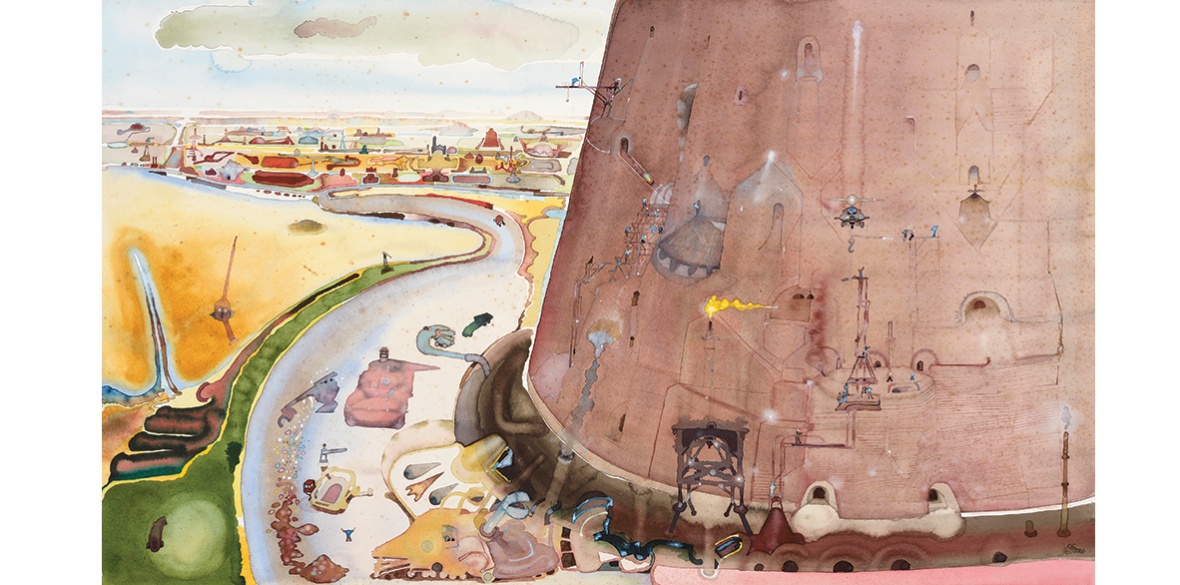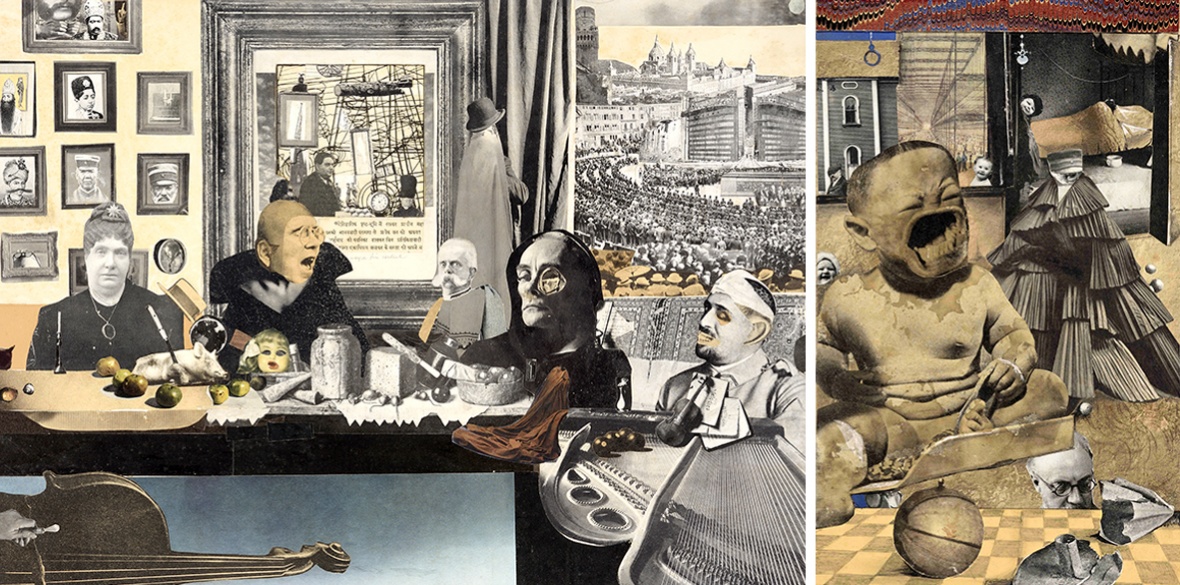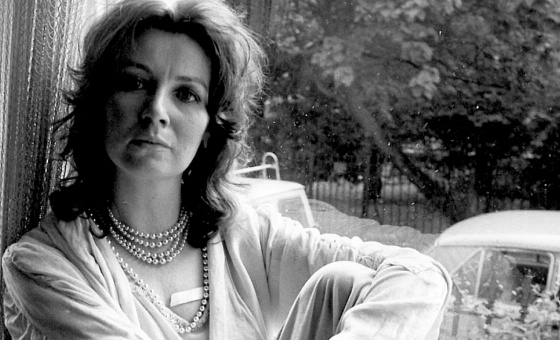This is the last article you can read this month
You can read more article this month
You can read more articles this month
Sorry your limit is up for this month
Reset on:
Please help support the Morning Star by subscribing here
Twist and Shout
David Evans
Three Highgate, London
EPIC watercolour seems like a contradiction in terms, but that rather genteel medium, stereotyped by English evening classes and the Sunday morning easel was handled with vitality and drama by David Evans (1929-1988).
Resistance in watercolour is a juicy term coined by the exhibition’s curator Alistair Hicks, whose fine essay on Evans in the 2017 Liss Llewellyn Fine Art catalogue (on sale in the gallery) fixes his star in the constellation of post-war British art: among Edward Burra, Peter Blake and David Hockney.
Further back we find soulmates in Turner and Samuel Palmer in his landscapes. Well yes, male artists all, but at least pointing up that watercolour has balls.
And here’s another one – Evans’s often surreal graphic style is compared with Edward Lear. Quite the talent but very few people have heard of David Evans outside the dealer establishment.
This new show Twist and Shout at Three Highgate should put that right. Featuring large figurative watercolour paintings, he’s as good a portraitist as a landscape artist, getting beneath skin and topsoil respectively.

His interiors too (concert halls, clubs) are powerfully vivid, and you want to sink your mind into them, roll around like a pig in muck.
Evans’s palette is ice cream parlour when it suits, or richly primal otherwise. This is poetry in paint, spectacular but never spectacle for its own sake.
The paint is poetic not slick, morphing into various feeling states. And the collages and montages. Crikey they’re good; the juxtaposition of images are careful, precise and meaningful in their dreamlike surreal quality.
On process Evans was interesting: “Most of the time we are offered by artists only what they have partly digested or more than not what they are still chewing in their mouths... I don’t think anyone produces anything of value until it has actually got into the bloodstream.”
This is profound and says a lot about how we subliminally receive art, as well as live as artists.
Gay before it was legalised (imagine that?) Evans moved to Potash farm in Suffolk with his partner Basil Lawrence in 1969. Self-sufficiency and integrity in living, celebrating the countryside and the immediate joy of it, were the order of each day.
Evans was an activist and environmentalist too, but his is not political art of the direct polemic. In his essay Harmony and Discord in the Age of Glam Rock in the 2017 catalogue Paul Liss of Liss Llewellyn observes: “[Evans’] compositions are characterised by a kaleidoscopic vision of Thatcher’s Britain: an era of urban redevelopment, the Falklands War, industrial unrest, nuclear power, and the Cold War. Transition is everywhere: new roads carve their way through the countryside; fighter jets cast their shadows across the landscape; the scars left by industrial plants, pylons and landfill permeate throughout.”
No, it didn’t him earn a living – it could have – but he chose to work as a hospital porter. He was killed on his way to work one day in 1988, riding his bike on to the A12.
Evans’s friend of 26 years – poet, composer and blues vocalist Pete Gage (Dr Feelgood, The Pete Gage Band) talked to me about his friendship with Evans. He recalls there were only three people at Evans’s funeral, himself, Basil and Basil’s sister.
Gage got to know Evans as a 15-year-old at Record Roundabout in London’s Brompton Road, a classical music shop that Evans ran in the 1960s, and a hangout for fellow creatives.
Evans loved and understood classical music, judging harshly anyone who would listen to their favourite bits (the Classic FM syndrome) and not the whole, as intended by the composer. For him, I guess, missing out an adagio was as wrong as stripping out the cadmium yellow from a painting.

The place was a spiritual and creative lifeline for Gage who used the word pulsating about Evans’ work. In his essay in the 2017 catalogue he writes: “... it was a seemingly endless period of learning. School meant very little to me, but what I learned from David about life, art and music, good food and conversation, was irreplaceable.” And so, the mentor rather than the teacher.
Gage spoke a lot about this. Learning by osmosis. It probably goes on all the time when we are not in the more guarded environments of formal learning.
Gage writes profoundly about stages of life and death in his own seven-part poem, To You, My Gerontius. A previous work on this theme is John Henry Newman’s poem on the afterlife journey The Dream of Gerontius, Edward Elgar’s classic work, which Gage and Evans listened to together.
Gage’s version is more Buddhist, and I think more profound as it mainlines his friendship with Evans and their conversations about “the artist’s Eternal Moment:”
“Your sweet sighs of recognition will rise / From the empty soil of your grey evening;/ Dusk, this doleful hour, twilight at your gate,
Mellow moments melting on the ground,
To You, My Gerontius, part 3, Pete Gage.
A poem in watercolour I feel. But in the spirit of listening to a whole work – read it all. How about a Blues Buddhist oratorio?
Evans shows us what art is for. For other artists – and that COULD be all of us – his use of paint in-spires in the literal sense of the word to breathe in life itself through colour and form as it relates to what’s around us.
Oof – yes, I could smear the colour that way – a slick of cobalt blue there – juxtaposed with warm ochre, and as this is watercolour splash some colour with water and make a bloom or two. The eye will tell you when it’s right. The eye of the artist that is – and a gift for the beholder.
He makes you want a paint box for Christmas. If you’ve already got one get on with it, but don’t expect to produce a David Evans. I’ll give Pete Gage the last word: “effervescent.”
Twist and Shout Three Highgate London N6, till July 12. Free. Opening times Thur and Sat 2-6pm; Sun 12-4pm. All other days by appointment.








